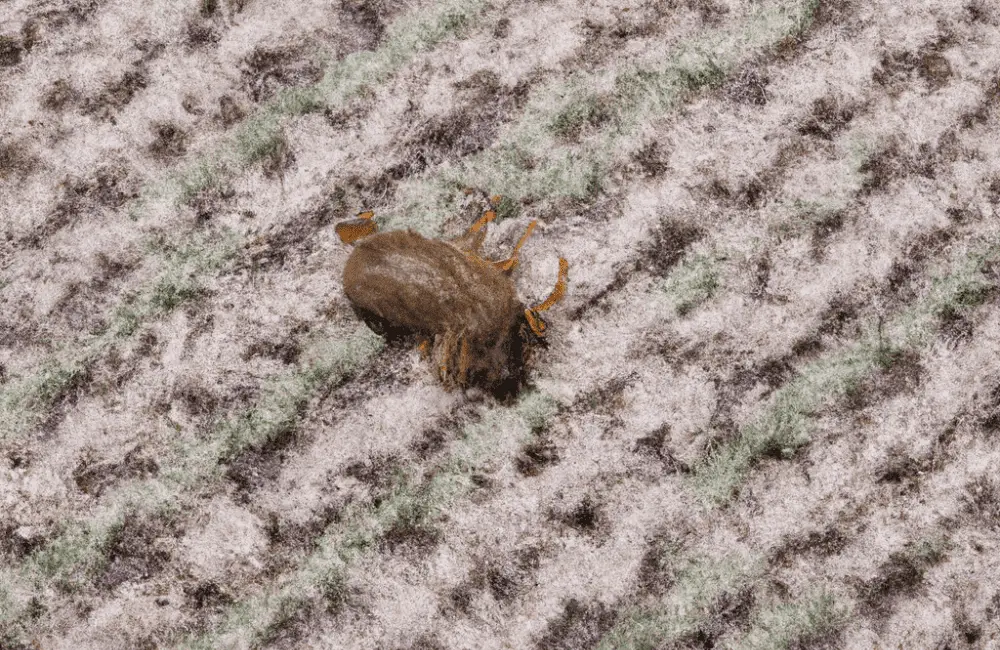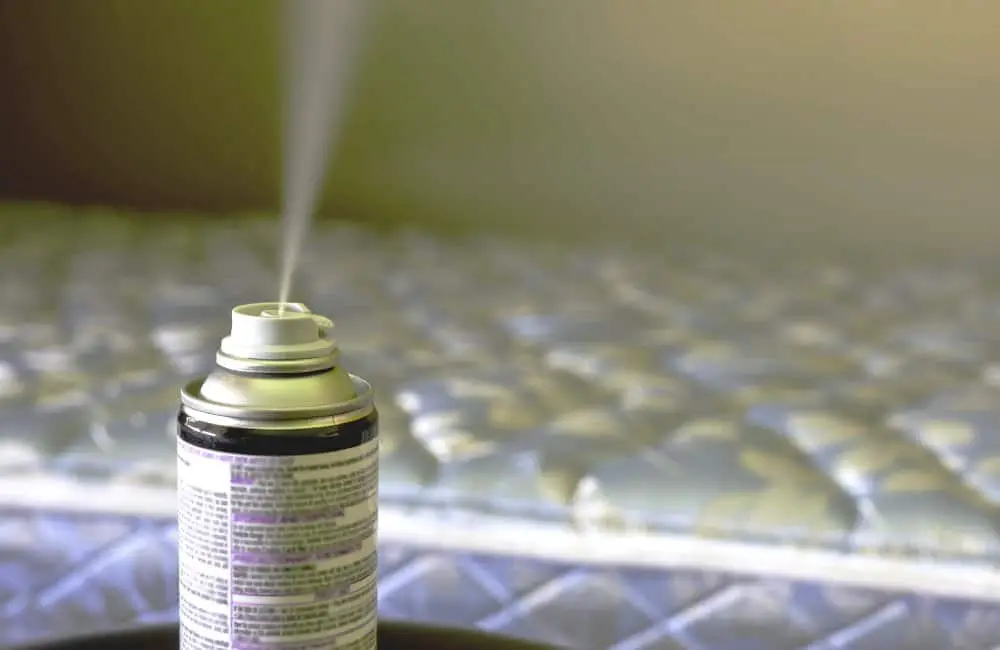Flea bombs are a last resort for getting rid of pesky adult fleas and linger long enough to kill any remaining flea eggs and the flea larvae that hatch from them.
They can treat a room, or many can be sued to fumigate the whole house, and when the smoke clears, you should find far fewer female fleas to lay flea eggs and continue the flea life cycle in your home.
Key Points:
- Flea foggers release a strong concentration of gaseous pesticide and are effective on a range of indoor pests.
- Pets and plants should be removed before flea fumigation, and all flame sources must be extinguished or switched off to avoid risks with the gas.
- Adult fleas will die within 2 days of exposure, while eggs and flea larvae can take up to two weeks for full elimination.
But will one application of a flea bomb be enough to completely wipe out all the fleas? Will the typical flea fogger found at a hardware store suffice, or do I need one from a professional pest control company?
And if applied correctly, will a flea bomb completely kill all the fleas, and if so, how quickly?
Find out the answer to all these questions and more below.
How Long After a Flea Bomb Are All Fleas Dead?
When a flea bomb release valve is let go, some fleas die instantly if exposed to direct contact with the fog. The active ingredients in the flea bomb canisters are able to quickly wipe out many of the active pest populations but cannot instantly kill all fleas in the room.
Fleas that are not directly exposed can survive the initial blast of the flea bombing, and so can eggs that have not yet hatched.
Most adult fleas will die after a couple of days, and a noticeable reduction in flea infestation signs should be observed. Since female fleas can lay up to 25 eggs per day, both affordable flea bombs and high-quality flea foggers provide residual toxicity for weeks after treatment.
Eggs and juvenile fleas in deep cracks can be killed up to 2 weeks after the initial spray if chemicals remain on the floor. Repeat flea treatments may be needed if re-infestation takes place 3 to 4 weeks after the bombing and the existence of fleas has decreased in a matter of days after treatment.
What Are Flea Bombs and Fumigators?
These are the final solutions to completely gas a room or home and eliminate anywhere for fleas to hide while creating a residue that can kill fleas as they hatch. Foggers can be applied by homeowners or done by flea extermination services to get rid of flea infestations that have grown out of control.
Generally, a strong concentration of gaseous pesticide is stored inside a canister that is sealed. When application time comes, the release valve is pulled, and the lethal pesticide explodes out.

In addition to being an excellent method of household flea control, the flea bombing formula is effective on a range of other indoor pests and can help get rid of most pests in your home. Flea fogger products can kill on contact and leave a residue that can kill bugs even two weeks after the initial application.
Always follow all instructions and safety tips before using flea bombs as a flea elimination treatment.
How Are Flea Foggers Used?
Safety is essential, and without taking the proper pre and post-application precautions, you and your pets could suffer the consequences. Some important safety information below can help increase the chances your fogger will be effective and keep you and your loved ones healthy.
Remove Pets and Plants
The poisons and high concentrations of chemicals in flea bombs can kill pets and household plants that are in the area of the flea fogger coverage. All pets and plants should be removed from inside the room being fumigated and outside of the home if possible to prevent any accidental ingestions.
Fish tanks must be sealed airtight if they cannot be removed, or they will die. Plants can be placed out of the fogger range and only need to avoid direct foliage contact.
Switch off Fuses and Extingish Pilots
The gaseous form of the fogger can be flammable and could ignite if any flame sources are exposed. Though unlikely, a shorted wire could create a flame-inducing spark that could ignite the gas, and so breakers to treated rooms can be turned off to further reduce risks.
All candles and fireplace fires should be extinguished as well before starting any flea fumigation or spraying of aerosols with insecticides.
Use Only One Bomb Per Room
Flea foggers come in various sizes to cover different areas of space, and it is important to select a bomb that is the right coverage. If your room is 300 sqft, find a bomb that treats that area, and do not combine 3 100 sqft bombs in one room.
The flea population can be best killed by saturating the room with the correct dosage of pesticide based on the instructions on the flea products.
Place the Bomb on Paper or Cardboard
The sudden expulsion and large amounts of gas discharged when the bomb goes off can stain and potentially damage the floor, so it is best to protect your room from that.
Simply placing a thick stack of paper or a sheet of cardboard directly under the bomb can prevent these issues. Make sure to dispose of these floor covers properly along with the bomb, as they will be saturated with chemicals and highly toxic.
Advise Respiratory Compromised Relatives to Stay Away
If someone in your family suffers from a respiratory illness such as asthma, they will want to avoid homes that are being fumigated. Even if only one area is being treated, the fumes have the potential to linger and insight irritation in compromised lungs.
To avoid any unintended complications, these relatives should remain away until the room is completely cleaned after the two-week residual time frame.
Remove Food and Cookery
Anything that will come in contact with something that will go into our mouths must be removed from the premise or stored in an airtight container.
The poisons that kill fleas can harm humans if ingested, so p[preventing any contamination is critical for your health and safety when you return to the home after the treatment time.
Apply with Protective Gear
Always handle the canister and release the valve while wearing gloves, long sleeves, eye protection, and a respirator mask. Bug bombs need to be placed in the center of the room for full effect,
and in most cases, the gas will start to release before you are able to exit the room entirely. The protective gear keeps you from ingesting any fumes on your way out and can buy you time if you need to deal with something before leaving the room.
Place the Bomb in Open Location and Not Enclosed or Contained
Anything that releases with force will explode harder if contained. While the area of effect will be lower, the impact in the contained area will be greater. If you release a flea bomb in a cupboard, it could explode the cupboard and will not treat the entire room.
Make sure flea bombs are released in the middle of the room and uncovered for the best results.
Effects of Fleas on Pets
Fleas are not just a nuisance they bring our furry friends great discomfort and can directly lead to some serious and potentially life-threatening illnesses. Even the sight of them constantly scratching is enough to move most pet owners to find a way to get rid of these pesky pets and relieve the pain of their constant bites.
Below are some of the effects fleas can have on our pets and the signs you need to recognize to treat your furry family.
| Type of Infection | Effects | Signs |
| Tape Worm | Pet eats an infected flea, and a tapeworm grows that steals the nutrients from the food your pet is eating | Your pet is eating constantly but losing weight and energy |
| Anemia | Your pet loses too much blood and becomes weak and sickly | Lack of appetite and lethargy are signs your pet could be experiencing anemia |
| Scabs and Hair Loss | Your pet scratches and bites at flea marks constantly and begins to lose hair and open wounds on their skin | Constant scratching and noticeable wounds and patches |
| Rashes and Infections | Open sores accumulate bacteria and become infected, leading to a range of health issues for your pets | Loss of appetite, fever, and sleeping more as well as enflamed flesh and red bumps |
Will a Flea Bomb Kill Them Instantly?
There is a chance that the fleas nearest the epicenter will drop dead at the time of the initial bombing. This so-called impact will wipe out a fair share of the active adults currently jumping and exposed in the open areas of the room.
Direct contact with the fog will kill fleas instantly, but a bomb goes further to ensure that a residual film can kill hiding adults and emerging larvae for weeks after the explosion.
What If I see Fleas After the Bombing?
It is normal to still see some fleas after the bombing. This is a good way to gauge if the flea infestation is lessening and if the treatment was successful.
Fleas should begin to be noticeably slower and fewer as the days go by. After a week or so, you should no longer see adults jumping around, and if you do, that could be an indicator that other parts of the home are infested as well.
How Long to Be Completely Free of Fleas?
When applied correctly and all instructions followed, there is a good chance the room or home that was fumigated will be flea free in two weeks. 14 days is a safe time to see that the entire adult generation, as well as larvae and already lain eggs, have developed and died.
Once this time frame is done, a thorough cleaning can ensure that nothing is left, and finally, an application of a natural flea repellent should be all that’s needed to avoid any nasty reinfestations.


